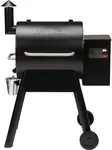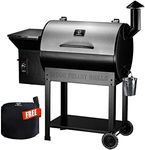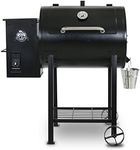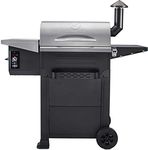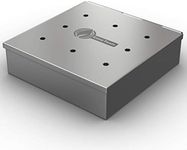Buying Guide for the Best Pellet Smokers
Choosing the right pellet smoker can make a big difference in your outdoor cooking experience. Pellet smokers are popular because they combine the flavor of wood smoking with the convenience of set-and-forget cooking. When shopping for a pellet smoker, it's important to understand the key features that affect performance, ease of use, and the types of food you can prepare. By focusing on the main specifications, you can find a model that matches your cooking style, space, and how much food you want to prepare at once.Cooking AreaThe cooking area refers to the total space available for placing food inside the smoker, usually measured in square inches. This is important because it determines how much food you can cook at one time. Smaller cooking areas (under 500 square inches) are suitable for singles or small families, while medium (500-700 square inches) can handle gatherings or larger families. Large cooking areas (over 700 square inches) are best for entertaining or cooking big cuts of meat. Think about how many people you usually cook for and what types of food you want to smoke to decide what size is right for you.
Temperature RangeThe temperature range tells you the lowest and highest temperatures the smoker can reach. This matters because different foods require different cooking temperatures. A lower minimum temperature (around 150°F) is good for slow smoking and delicate foods, while a higher maximum (up to 500°F or more) allows for grilling and searing. If you want to do more than just smoke—like bake, roast, or grill—look for a wider temperature range. Match the range to the types of cooking you plan to do most often.
Hopper CapacityHopper capacity is the amount of wood pellets the smoker can hold at once, usually measured in pounds. This is important because it affects how long the smoker can run without needing a refill. Smaller hoppers (under 10 lbs) may need refilling during long cooks, while larger hoppers (15 lbs or more) can run for many hours unattended. If you plan to do long, slow cooks or want to avoid checking the smoker often, a bigger hopper is helpful. Consider your cooking habits and how much attention you want to give the smoker during use.
Build MaterialThe build material refers to what the smoker is made from, such as steel thickness and quality of components. This matters for durability, heat retention, and weather resistance. Thicker steel and high-quality finishes help the smoker last longer and maintain steady temperatures, especially in colder weather. If you plan to use your smoker often or leave it outdoors, look for sturdy construction and rust-resistant materials. Think about how often and where you'll use the smoker to decide how much importance to place on build quality.
Control SystemThe control system is how you set and monitor the temperature and cooking process. Basic models use manual dials, while advanced ones have digital controls, Wi-Fi, or Bluetooth connectivity. This is important for convenience and precision. Digital and smart controls make it easier to set exact temperatures and monitor your cook from a distance, which is great for busy cooks or those who like tech features. If you prefer simplicity, a manual system may be enough. Choose a control system that matches your comfort with technology and how hands-on you want to be.
PortabilityPortability refers to how easy it is to move the smoker around. Some pellet smokers are heavy and designed to stay in one place, while others have wheels or are compact for easier transport. This is important if you plan to take your smoker to tailgates, camping, or move it around your yard. If you need to move your smoker often, look for lighter models or those with sturdy wheels. If it will stay in one spot, portability may not be as important.

